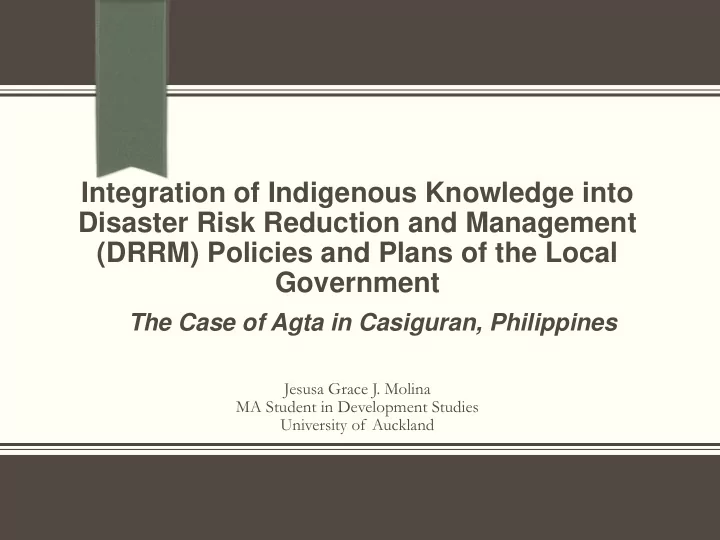

Integration of Indigenous Knowledge into Disaster Risk Reduction and Management (DRRM) Policies and Plans of the Local Government The Case of Agta in Casiguran, Philippines Jesusa Grace J. Molina MA Student in Development Studies University of Auckland
Overview 1 Background 2 Research Question 3 Theoretical Framework Framework 4 Methodology 5 Findings & Implications Conclusions
Background § High vulnerability of indigenous peoples ( Scott, Llamas-Cabello, & Bittner, 2013 ) § Neglect of policy-makers and authorities to indigenous peoples ( Bankoff, Frerks, & Hilhorst, 2004) § Increasing call for integration of indigenous knowledge and science in DRRM ( Gaillard & Mercer, 2013; Hiwasaki et al., 2014 )
Research Question Perception of disasters Indigenous and its impacts knowledge to key hazards How is the indigenous knowledge of Agta integrated into the DRRM policies and plans of the local Ways toward government? integrating IK Existing mechanisms for integrating IK in Text the plans and policies Challenges in integrating IK
Theoretical Framework Rights-based approach, incorporated with the process framework for integrating indigenous knowledge and science (Gaillard, Mercer, Kelman, Taranis & Suchet-Pearson, 2013; 2010)
Methodology Village Municipal Validation Workshop Village Municipal Document Analysis Village Participant Observation Village Municipal Semi-structured Interview National
Findings: Collaboration … The Agta’s lifestyle is different compared to others which explains why most of them are impoverished. There are times when you provide financial assistance, the Agta just use it for drinking alcohol. They usually go home drunk. I always tell them to build and protect the reputation of their tribe given their poor condition. They are not like other indigenous peoples such as Igorot who are very hardworking. The Agta are really different… (Female Local Government Officer, 2014) … The Barangay Council does not consult us in planning for disasters and other development activities. When decisions are made, they just consult those who are close to them. You know, patronage politics. That’s how things work… (Female Agta, 2014)
Findings: Existing Indigenous Knowledge of Agta Sample Observations • Ants transport food to an elevated area Animal Behaviour • Some seashells crawl upward • Birds (i.e. Philippine hornbill) squeak and become playful • Monkeys hide in the forests • Red sunrays in the West Atmospheric • Cloud movement and colour Changes -Clouds appear dark, thick and move fast • Wind movement -Strong and warm winds from the East -Habagat (southwest monsoon) Natural environment • Silence in the surroundings • The sea looks shallow
Findings Non-Agta’s Perception on the DRRM Role of Indigenous Knowledge …I grew up here in Casiguran and I also depend on environmental observations for warning such as the appearance of red sunrays, which signals the arrival of a typhoon. However, there are times that this knowledge is inaccurate especially nowadays. You know why? It is because of climate change… (Male Local Government Officer, 2014)
Findings: Integration of IK with Science …We go there and our representative whom we expect to speak up and share our needs and situation is not acknowledged. Maybe the Barangay Council or the Municipal Government takes us for granted. Because of this treatment, the indigenous peoples do not have the drive to participate anymore given that the same thing always happens. We feel left out. Instead of approaching the Barangay Council or the Municipal Government, we prefer to seek help from NGOs… (Agta Leader, 2014)
Policy Implications § Representation of indigenous peoples § Popularisation of indigenous knowledge § Mainstream indigenous knowledge in other sectors (i.e. education, health and livelihood)
Conclusions § The Philippines is in the infancy stage of integration § Validation of indigenous knowledge is needed to reveal its empirical basis
Thank you!
Recommend
More recommend